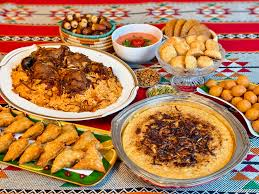Traditional Saudi Arabia food is much more than a meal. It is a strong reflection of the kingdom’s rich heritage, deep traditions, and family values. From ancient cooking styles to modern table customs, food in Saudi Arabia holds meaning beyond taste. In this article, we will explore how traditional Saudi dishes show the nation’s culture in seven surprising ways.
What Is Traditional Saudi Arabia Food?
Traditional Saudi Arabia food includes dishes that have been passed down for generations. These recipes often use locally available ingredients like dates, wheat, rice, lamb, spices, and yogurt. Meals are usually served on large platters and shared with family and guests, reflecting hospitality—a core Saudi value.
1. Use of Local Ingredients Reflects Desert Life

Saudi Arabia has a harsh desert climate, and this is clearly seen in its food. Dates are one of the most common ingredients. They grow easily in the region and have long been used as a source of energy. Along with dates, flatbreads made from wheat, camel milk, and dried fruits show how people adapted to the environment.
Dishes like Mutabbaq (stuffed pancake), Areeka (crushed bread with honey and dates), and Harees (a wheat and meat porridge) come directly from this connection to the land. This shows how food in Saudi Arabia is not just about taste, but survival and smart use of resources.
2. Family and Community Are Central to Every Meal
In Saudi homes, meals are usually eaten together, seated on the floor. This tradition builds strong family bonds and teaches respect for elders. Large dishes like Kabsa—a rice and meat dish—are made for sharing. The act of eating from the same plate encourages closeness and humility.
Hospitality is key in Saudi culture. Guests are offered food and drink immediately, often starting with Arabic coffee and dates. These customs reflect generosity, one of the most respected values in Saudi society.
3. Islamic Influence Shapes Food Habits
Islam plays a major role in shaping traditional Saudi Arabia food. The Islamic dietary laws, known as Halal, guide what is allowed to be eaten. Pork and alcohol are strictly avoided. The process of slaughtering animals must also follow specific religious steps.
During Ramadan, the holy month of fasting, food takes on even deeper meaning. Families gather to break their fast with dates and soup before the evening meal. This strengthens the connection between food, faith, and family.
4. Ancient Cooking Techniques Still Used Today
Despite modern kitchens, many traditional cooking methods are still used in Saudi Arabia. Slow cooking in underground pits, clay ovens, and stone stoves are common. One example is Mandi, where meat is cooked with rice in a deep pit for several hours. This method gives the food a smoky, rich flavor.
These old techniques are passed down from elders to younger generations, keeping the culture alive. Cooking is often a family affair, and learning how to prepare dishes becomes a cultural education in itself.
5. Cultural Identity in Every Region
Saudi Arabia is a large country with many different regions, and each area has its own signature dishes. In the Najd region, wheat-based dishes like Jareesh are popular. In the coastal areas like Jeddah, seafood dishes such as Sayadeya are common. In the south, you might find Areekah and Hininy made with dates and ghee.
These regional dishes show how culture and geography mix. They highlight the diversity within Saudi identity while still remaining connected to the overall tradition.
6. Spices Tell the Story of Trade and Travel
The spice blends used in traditional Saudi Arabia food reveal a long history of trade. Saudi Arabia was part of ancient spice trade routes that brought cinnamon, cloves, cardamom, and saffron into the region. These spices are still widely used in dishes today, adding flavor and fragrance to the cuisine.
Dishes like Kabsa and Margoog are rich in spices, showing how food can tell the story of a nation’s past, its connections with other cultures, and its openness to global influence.
7. Celebrations and Festivals Are Full of Traditional Dishes

Special dishes are prepared during religious holidays, weddings, and other celebrations. Thareed, a dish made with bread soaked in stew, is often served during Ramadan. Maamoul (date-filled cookies) are popular during Eid.
These dishes bring people together and make events memorable. Traditional food becomes a symbol of joy, unity, and heritage. It also connects the younger generation to their roots during modern-day celebrations.
Why Traditional Food Still Matters Today
In the age of fast food and global cuisine, Saudi Arabia continues to protect its traditional food culture. Many young people are now learning to cook from their grandparents and share recipes online. Restaurants across the kingdom are including old-style dishes in their menus. Schools and cultural programs also encourage pride in national cuisine.
Preserving traditional Saudi Arabia food is important not just for taste, but for keeping values, history, and identity alive. It is a bridge between the past and the future.
Conclusion: A Culture Served on a Plate
Every bite of traditional Saudi Arabia food tells a story. It shows where people came from, what they value, and how they live. Through ingredients, cooking methods, and shared meals, food becomes more than just nourishment. It becomes culture on a plate.
Understanding Saudi Arabia’s food is one of the best ways to understand its people. Whether it’s a date offered in hospitality or a slow-cooked lamb dish at a wedding, food is a language that everyone can understand—and in Saudi Arabia, that language speaks loudly of tradition, respect, and unity.
Also Read – Business Success: 7 Smart Reasons Predictive Talent Analytics Saves You



